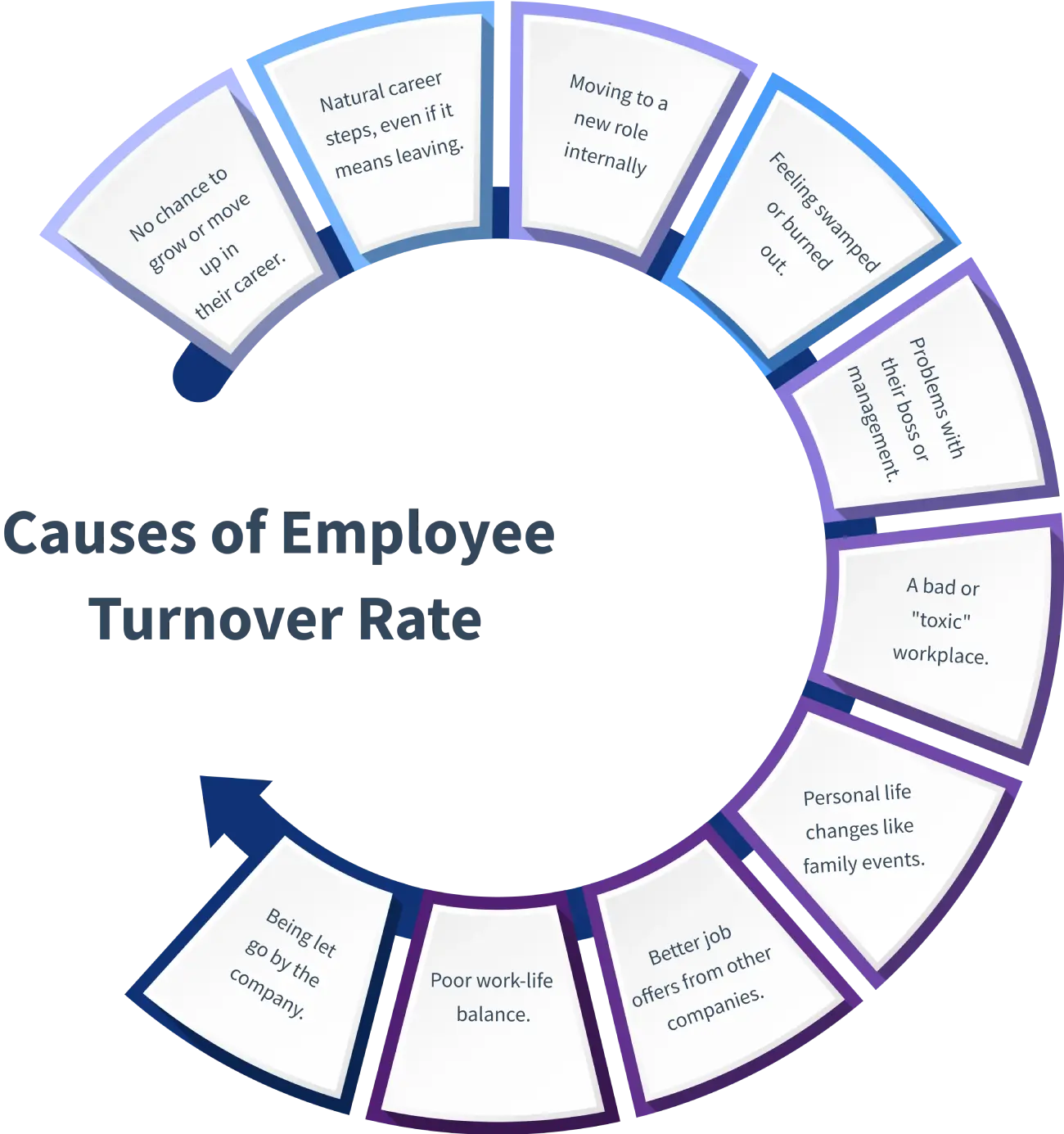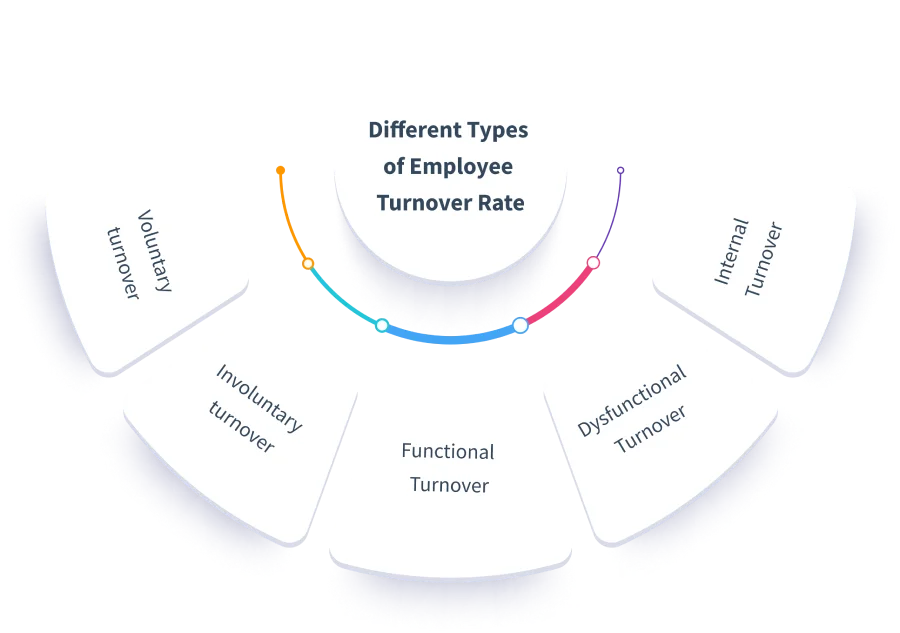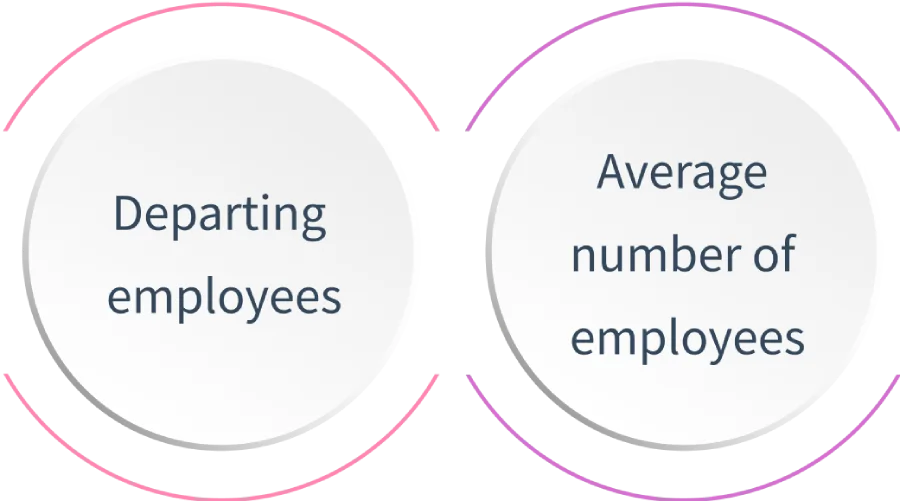Home / E / Employee Turnover Rate
Employee Turnover Rate: Causes, Types & How to Calculate
Employee turnover rate is the amount of employees that leave an organization in a given time period (i.e., employees may resign, terminate, or retire). It enables organizations to measure the stability of the workforce, evaluate the efficiency of their hires, and identify how engaged employees are with their job. The higher the turnover rate, the more serious problems the organization may be experiencing (i.e. management problems, dissatisfaction with a job, lost growth opportunities, etc.).
What Is Employee Turnover Rate?
Employee turnover rate is a metric that shows how many employees leave a company in a certain timeframe in both voluntary (for example, resignations) and involuntary (for example, layoffs, dismissals) turnover. It is an important measure organizationally because it shows employee satisfaction , employee retention effectiveness, and employee conditions based on workplace culture. Frequent employee turnover could indicate larger issues, whereas infrequent employee turnover may indicate employees are engaged, and management is effective.
What Are the Causes of Employee Turnover Rate?

High turnover often points to issues inside the company. For instance, a recent report showed a big reason people quit is not being paid enough – 74% of employees in that survey left for better pay!
Other common reasons for employee turnover:
- No chance to grow or move up in their career.
- Natural career steps, even if it means leaving.
- Moving to a new role internally (like a promotion or transfer) – though these usually aren't counted in problem turnover.
- Feeling swamped or burned out.
- Problems with their boss or management.
- A bad or "toxic" workplace.
- Personal life changes like family events.
- Better job offers from other companies.
- Poor work-life balance .
- Being let go by the company.
Knowing why employees leave helps businesses make smart changes to keep their teams stable. Companies need to look at their own unique situation and sector to set their ideal turnover goal.
What Are the Different Types of Employee Turnover Rate?

When we talk about employee turnover, it's not just a single number; it's a mix of different situations that lead people to leave the company.
Here are the different kinds of employee turnover rate-
- Voluntary turnover: When a company employee leaves a job without any kind of pressure.
- Involuntary turnover: When the company lets an employee go. This can happen if they're not doing well at their job, if they break company rules , or if the business is changing and needs fewer people, like during layoffs.
- Functional Turnover: When an employee leaves, it can sometimes be good for the company, especially if they weren't doing well or weren't a good fit. if people think of this type of departure as "functional."
- Dysfunctional Turnover: This is the opposite and more damaging, happening when a valuable, high-performing employee leaves. Losing top talent in this way can really hurt the company.
- Internal Turnover: It's not always included in the overall turnover figures, but it refers to when an employee takes a job in the same company, such as getting promoted or switching to work in another department.
How to Calculate Employee Turnover Rate?

All the employee turnover calculations give the number of people who depart a company in some period of time, a month or a year, for instance. It includes all those who quit or were fired.
Employee Turnover Rate = Departing employees / Avg number of employees

Now, for our estimate, these words are these:
- Departing employees: All employees who left the company, whether they chose to leave (as quitting) or were told to leave (as in being let go).
- Average number of employees: These are the people who usually work for the company during the time period at which we’re looking.
What Are Effective Ways to Reduce Employee Turnover Rate?
Here are five straightforward ways to do just that:
- Hire the Right Fit: It is not just the skills you are looking for; you need people who will truly fit in with the vibe of your company.
- Pay Fairly and Provide Good Benefits: Workers want fair compensation . Verify what rivals are offering and add perks that your team values—it's not just about pay.
- Express gratitude and feedback: Reward hard work! People are far less likely to hunt for new employment when they feel valued and respected.
- Give Them a Way: Most people desire to develop. If they can't see how to move up in your company, they'll find that path somewhere else. Show them their future with you.
- Offer Flexibility: Life happens. Giving employees options like flexible hours or remote work makes a huge difference to their happiness and their decision to stay.
How Does Employee Turnover Rate Vary Across Different Industries?
Just knowing how many people leave your company each year doesn't tell you much on its own. For example, the number of people quitting a fast-paced tech company in Bengaluru will be very different from those leaving a factory.
The following are some typical turnover rates in various fields that you may observe in India at the moment:
- It typically ranges from 17% to 20% across India.
- IT Sector: typically higher, ranging from 15% to 25%.
- Financial Services: About 24% to 25% of the time, they are typically on the higher end.
- Manufacturing: Typically lower, ranging from 10% to 12%.
These figures demonstrate how crucial it is to understand the norms in your field. It assists you in determining whether your turnover rate is appropriate or excessively high, or low.

